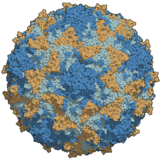Portal:Viruses/Selected virus/4
Poliovirus is an enterovirus, an RNA virus in the Picornaviridae family, associated with the paralytic disease polio. The icosahedral virus particle is about 30 nanometres in diameter and lacks an envelope. It contains a relatively short, single-stranded positive RNA genome of around 7500 nucleotides, which encodes about ten viral products. The virus has a fairly high mutation rate even for an RNA virus. Historically there were three serotypes, each with a slightly different capsid protein; PV1 is the most common, and PV2 was declared eradicated in 2015.
The virus only naturally infects humans, although some monkeys can be infected experimentally; 95% of infections are asymptomatic. Infection occurs via the faecal–oral route and viral replication occurs in the alimentary tract. The virus enters the host cell by binding to an immunoglobulin-like receptor, CD155. Fully assembled poliovirus leaves the cell 4–6 hours after initiation of infection. Poliovirus was first isolated in 1909 by Karl Landsteiner and Erwin Popper. Its genome was sequenced in 1981. Among the simplest clinically significant viruses, poliovirus is one of the best-characterised viruses, and has become a useful model for studying RNA viruses.

